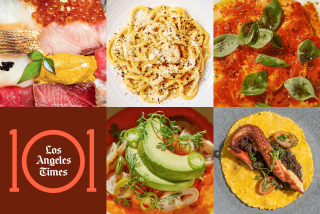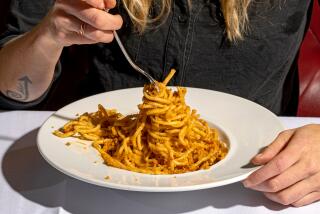Food fight grows over the cream of the crop
Josiah Citrin was livid. As chef-owner at Santa Monica’s Melisse -- one of only three Michelin two-star restaurants in Southern California -- Citrin is used to getting what he wants, particularly when it comes to sweet, fresh English peas. But Wednesday morning, the McGrath Family Farms stand at the Santa Monica Farmers’ Market was sold out, and Citrin was on the warpath.
It wasn’t a matter of the peas not being there that made him angry; he could see boxes of them behind the table. But they had all been ordered in advance -- mainly by produce companies that would sell them to restaurants and markets across the country.
“The chefs who actually come to the market every week need to be supported,” Citrin fumed to anyone who would listen -- and quickly a who’s who of the L.A. food scene gathered around: Jason and Miho Travi of Culver City’s Fraiche, considered by many the best new restaurant in Southern California; Donato Poto of seafood temple Providence, Vicki Fan and Kazuto Matsusaka of trendy Beacon, Mark Peel of landmark Campanile.
Quinn Hatfield, chef-owner at the tiny, highly regarded Hatfield’s on Beverly Boulevard, joined in.
“This is my last day here,” he said. “I don’t want to compete with the produce companies. Look at all of these trucks. This isn’t a farmers market anymore; it’s some kind of boutique wholesale operation.”
It may seem like a tempest in a pea pod, but it’s one more sign that the Wednesday Santa Monica Farmers’ Market, one of the most cherished food institutions in Southern California, is undergoing profound change.
Though ordinary shoppers can still rub elbows with famous chefs while buying just-picked fruits and vegetables from folksy farmers, there is no denying that the market has also become an important economic engine.
Those same fruits and vegetables you buy for your family might also wind up on tables at fancy restaurants in Las Vegas and New York, flown out by major produce companies such as LA Specialty and FreshPoint Consolidation, a subsidiary of restaurant supply giant Sysco Corp.
Inspired by the chefs, home cooks have adopted many of the ingredients themselves, and now former rarities such as Meyer lemons, blood oranges and fingerling potatoes can be found at high-end supermarkets across the country, many of them bought at the Santa Monica Farmers’ Market by specialty produce distributors Frieda’s and Melissa’s.
For the small farmers who grow those items, the market is an economic lifesaver -- a place where they can earn more than commodity prices for growing ingredients that can’t be found elsewhere or that taste better than what the big farmers grow.
Though no hard figures are kept, some growers say that as much as half of what they sell at the market is bought by produce companies.
As a result, what had long been a kind of informal meeting place for many of Southern California’s foodies and chefs is no longer quite so clubby. What chefs once regarded as a combination of culinary laboratory and kaffeeklatsch -- a place to find new ingredients and ideas and swap gossip, sometimes seemingly in equal proportions -- is more and more a place for big business.
“It used to be that everyone thought how great it was to be out there picking things for ourselves; it was so exciting,” said Matt Molina of the white-hot Mozza restaurants, co-owned by star chefs Mario Batali and Nancy Silverton. “Then all of a sudden it began to become a business, a big-money business. Now farmers are sometimes catering to the big people, so local restaurants are sometimes getting left behind.
“I can understand why Quinn [Hatfield] gets upset. It’s turned into a very tricky market. It’s not just this little mom and pop thing anymore, the way it was back 20 years ago.”
Farmers markets started out in the late 1970s as a way to help small farmers and bring fresh produce to home cooks. Chefs, drawn by just-picked freshness and often hard-to-find ingredients, enthusiastically adopted them.
And gradually the markets became something more than just a place to shop. Cooking in a restaurant, even a very fine one, can be isolating -- both creatively and socially. Night after night, chefs churn out the same menu items, and the only way they can meet other professionals is by driving across town for a late drink after closing.
Surrounded by ingredients at farmers markets, chefs found that they could let their imaginations roam free of the constraints of the menu. Many items that we now regard as fine dining staples got their start this way. What could you do with the green garlic some farmers brought in? Or all of those fava beans? Or stinging nettles, for goodness’ sake?
At the same time, chefs could connect with their colleagues, catch up on family news or compare linen services and valet parking companies.
Now they say that the increasing commercialism of farmers markets is threatening that. Today, along with shoppers and chefs, there are representatives of big commercial produce distributors walking the market, often trailed by workers with truck dollies to help tote away purchases.
Chefs, including Citrin and Hatfield, accuse corporate buyers of hogging the best produce, keeping it out of the hands of hardworking, hands-on cooks like themselves.
But Peel, who has been shopping at the Wednesday market most weeks since opening Campanile in 1989, points out that it wasn’t so long ago that the same complaint was being leveled by shoppers against him and other chefs.
“Farmers markets started as a way for farmers to sell directly to home cooks, then chefs started going there and home cooks would moan about the chefs coming in early and scooping up everything good,” he said. “I’m a chef, and I’d kind of roll my eyes and say, ‘Get out of bed earlier.’ Now the same thing is happening to us.”
The average shopper probably hasn’t noticed much of a difference. If you want to buy only a pound or two of English peas, they’re still there; it’s the 10-pound purchase that gets tricky. And as far as the real treasures are concerned, well, those have been out of reach for years. To get your hands on James Birch’s fragrant Persian mulberries or Jerry Rutiz’s candied wild strawberries, your best chance is befriending one of the chefs who have long claimed almost all of them.
Certainly, there’s nothing preventing Citrin and Hatfield from phoning in their orders in advance, as do other chefs and produce companies. But Hatfield says the spontaneity of choosing what’s best at the farmers market and letting it inspire his menu is one of the great things about being a chef.
“To me, that’s what going to the farmers market is all about,” Hatfield said. “If I’m going to have to pre-order things in order to be sure I get them, I might as well just stay in bed an extra of couple hours every Wednesday morning.”
Chris Kidder of Brentwood’s Literati II shops the market regularly, but he has started to pre-order more of the things he needs.
“But I am still going to go there to get other things I might not know about or to find the very best products,” Kidder said.
On the other side of the argument are farmers like Phil McGrath, he of the hotly sought sweet peas.
“Look, I don’t want to make anybody mad, but is it so hard to pick up the phone?” he asked plaintively. “Can’t they call us up the day before and say, ‘Hey are you coming down tomorrow? Could you bring some peas?’ ”
The issue goes well beyond mere convenience. Farming is a business that runs on highly perishable stock, and when something is harvested it must be sold quickly, particularly when it’s as fragile as English peas, which start to turn from sweet to starchy within hours of being picked. Peas that don’t get sold are good only for compost.
“Someone calls in an order, and that’s a sale that’s already made and paid for as far as I’m concerned,” McGrath explained. “When I bring something to the market and put it out on the table, that’s a gamble. I don’t know whether I’ll sell those or not.”
One of the most constant of the commercial shoppers at the Wednesday market is Karen Beverlin of FreshPoint. Her company ships produce from the Santa Monica Farmers’ Market all over the country, including to restaurants in Las Vegas and New York. But Beverlin said 90% of its sales are in Southern California, to customers as varied as Providence restaurant and the USC dining hall.
“I think we’re helping the family farmers who come to the market, and isn’t that what it’s all about?” she said. “I don’t haggle about prices with the farmers I buy from. . . . In most cases, I’m paying exactly the same prices for most of what I buy as you would if you just walked up to the table.
“We do want the farmers markets to remain vibrant, and I think we’re helping that on multiple levels: We’re helping them economically, we’re encouraging a vibrant community and we’re giving chefs access to high-quality, local, seasonal produce, much of it sustainably grown, even if they can’t come to the farmers market every week. How can that be bad?”
Caught in the middle is Santa Monica market manager Laura Avery, who has run the operation since 1982, just a year after it opened.
“There is certainly a wide range of opinions among farmers, among chefs and among the produce companies,” she said. “They’re all trying to get more small-farm produce into restaurants, which is great. But we want to be sure to keep stuff on the tables for regular customers and smaller restaurants who come every week.”
One idea Avery has been considering is separating the wholesale activity from the main market -- allowing it either before the 9 a.m. opening or at a different location.
“We’re all of us interested in helping the farmers, but we need to separate the two,” Avery said. “That’s what has to happen in a very nice, positive kind of way. Certainly, we’re victims of too much good stuff, of too many happy customers. But I think we can make it work.”
--
More to Read
Eat your way across L.A.
Get our weekly Tasting Notes newsletter for reviews, news and more.
You may occasionally receive promotional content from the Los Angeles Times.







